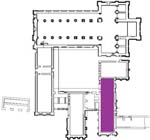|
|
You are here:

 (1/1) (1/1) |
Roche Abbey: the dormitory
Nothing remains of the monks’ dormitory
at Roche which extended almost forty metres along the upper level
of the southern range. It would have accommodated about sixty monks.
A staircase in the southern range of the cloister, next to the
warming house, provided access to the dormitory during the day,
but when the monks rose during the night to celebrate Vigils in
their choir, they used a different staircase that linked their
dormitory with the church via a covered passage which ran over
the chapter-house. The dormitory would have been lit during the
day by a series of windows and also one or two lanterns, which
were to burn at all times to prevent misconduct. These lanterns
were placed in such a way that they illuminated the monks’ latrine
block (the rerdorters), which was situated at the far end of the
dormitory.
In accordance with chapter 22
of the Rule
of St Benedict the monks
slept fully clothed ‘as if to prepare for the Lord’.
This was in part for reasons of modesty but also meant that when
the bell for the night office of Vigils sounded the monks did not
have to waste time dressing but could simply climb out of bed and
make their way to the choir stalls in the church. The monks lay
on mattresses filled with straw, which were arranged around the
room; there would have been a closet of sorts in the centre. Bedclothes
were to be either black or white and pillows of a moderate size.
At first all the monks slept in the dormitory, but later on it
was common for Cistercian abbots to have their own lodgings. The sacrist may
also have had a private chamber since he had to rise before the
others to sound the bell for Vigils, and keep an eye
on the goings on in church. In the fourteenth century the General
Chapter conceded that priors and sub-priors might construct
cells within the dormitory (i.e. rooms furnished with a lock) to
give
them greater privacy, and it is likely that at this time the other
monks had some kind of a partition. Michael Sherbrook’s account
of the spoliation of Roche in the sixteenth century mentions
that one of the monks tried (in vain) to sell Michael’s uncle
the door of his cell for two pennies, which suggests that, at least
by this time, the dormitory at Roche was divided into individual
cells.
A cautionary tale
A
tale recounted in the thirteenth century underlined the importance
of sleeping
fully clothed.
A certain monk who was unable to sleep one night saw, as
he was lying awake, the figure of a wondrous lady passing
through the dormitory. He watched how the woman walked around
the sleeping monks, blessing each in turn except for one,
whom she left out, and indeed averted her eyes when she passed
by him. The following day the monk reported what he had seen
to the unblessed monk, who, rather shamefacedly, admitted
that he had lain somewhat carelessly that night. It is not
clear whether he had slept without his girdle, sandals or
habit.
[Caesarius of Heisterbach,
The Dialogue on Miracles I, bk vii, ch. xiv
(p. 471)]. |
The monks were to
observe the strictest silence in the dormitory at all times, and
even sign
language was forbidden here.
<back><next
section>
|







 (1/1)
(1/1)